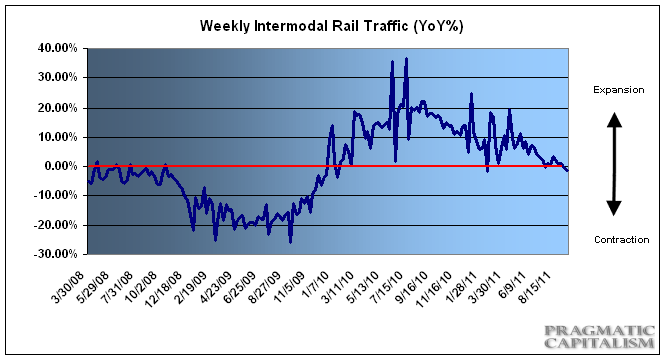The latest weekly rail traffic data from AAR shows a continued slide in rail traffic trends. Both carloads and intermodal traffic turned in negative year over year figures although the declines are marginal. Nonetheless, this is indicative of a very weak broader economy. AAR reports:
“AAR also reported a dip in weekly rail traffic, with U.S. railroads originating 303,260 carloads for the week ending September 3, 2011, down 0.4 percent compared with the same week last year. Intermodal volume for the week totaled 233,941 trailers and containers, down 1.3 percent compared with the same week last year.
Twelve of the 20 carload commodity groups posted increases from the comparable week in 2010, including: metallic ores, up 24.5 percent, and lumber and wood products, up 23.2 percent. Groups showing a decrease in weekly traffic included: farm products excluding grain, down 23.9 percent, and grain, down 21.4 percent.
Weekly carload volume on Eastern railroads was down 0.8 percent compared with the same week last year. In the West, weekly carload volume was down 0.2 percent compared with the same week in 2010.
For the first 35 weeks of 2011, U.S. railroads reported cumulative volume of 10,133,479 carloads, up 1.9 percent from the same point last year, and 7,931,620 trailers and containers, up 5.8 percent from last year.”

Source: AAR
Mr. Roche is the Founder and Chief Investment Officer of Discipline Funds.Discipline Funds is a low fee financial advisory firm with a focus on helping people be more disciplined with their finances.
He is also the author of Pragmatic Capitalism: What Every Investor Needs to Understand About Money and Finance, Understanding the Modern Monetary System and Understanding Modern Portfolio Construction.

Comments are closed.